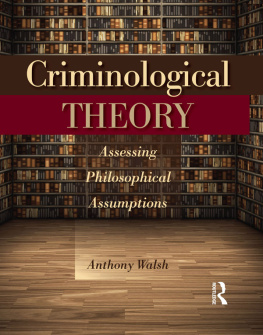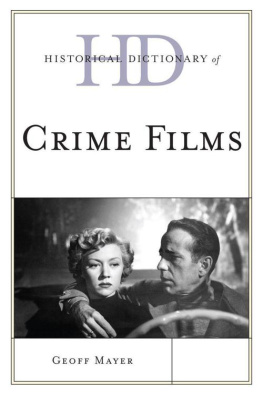Thank you for buying this ebook, published by NYU Press.
Sign up for our e-newsletters to receive information about forthcoming books, special discounts, and more!
Sign Up!
About NYU Press
A publisher of original scholarship since its founding in 1916, New York University Press Produces more than 100 new books each year, with a backlist of 3,000 titles in print. Working across the humanities and social sciences, NYU Press has award-winning lists in sociology, law, cultural and American studies, religion, American history, anthropology, politics, criminology, media and communication, literary studies, and psychology.
Criminology Goes to the Movies
Criminology Goes to the Movies
Crime Theory and Popular Culture
Nicole Rafter and Michelle Brown

NEW YORK UNIVERSITY PRESS
New York and London
www.nyupress.org
2011 by Nicole Rafter and Michelle Brown
All rights reserved
References to Internet websites (URLs) were accurate at the time of writing. Neither the author nor New York University Press is responsible for URLs that may have expired or changed since the manuscript was prepared.
Library of Congress Cataloging-in-Publication Data
Rafter, Nicole Hahn, 1939
Criminology goes to the movies : crime theory and popular culture/
Nicole Rafter and Michelle Brown.
p. cm.
Includes bibliographical references and index.
ISBN 9780814776513 (cl : alk. paper) ISBN 9780814776520
(pb : alk. paper) ISBN 9780814777411 (e-book)
1. Crime in popular culture. 2. Criminology.
I. Brown, Michelle, 1971
II. Title.
HV6030.R34 2011
364dc22 2011012522
New York University Press books are printed on acid-free paper, and their binding materials are chosen for strength and durability. We strive to use environmentally responsible suppliers and materials to the greatest extent possible in publishing our books.
Manufactured in the United States of America
c 10 9 8 7 6 5 4 3 2 1
p 10 9 8 7 6 5 4 3 2 1
Nicole Rafter dedicates this book to her daughter, Sarah Rachel Hahn.
Michelle Brown dedicates this book to her daughter, Sabine Wren Brown-Hoffman.
Contents
Preface
This book grew out of conversations about two problems we repeatedly encountered in our scholarship and in our teaching. As specialists in the area of crime and the media, we long ago realized that criminology is produced by not only scholars but all participants in popular culture, including everyone who rents or downloads a crime film or buys a ticket to a movie theater. In the past, we have written about the relationships between popular and academic criminology, demonstrating their overlaps and arguing that crime, while it is indeed a negative phenomenon, is also a cultural resource, one into which everyone dips for ideas about crime and justice. Discussing these matters in our writing and teaching, we often use movies as examples. This created the first problem. Not every reader of our books or student in our courses had seen the films we mentioned as illustrations. In the lead-up to this book, we tried to find a way to get our audiences on the same pageor, rather, the same screenso they would all understand our examples.
The second and much more general problem that this book addresses is pedagogical. All students majoring in criminal justice and criminology are required to take a course in criminological theory, but as any instructor can attest, about four weeks after the course has ended, if you ask a former student something about, say, strain theory, you get an anxious look and a bit of head-scratching. Even top-notch graduate students, when asked after a lapse of several months to relate a new idea to social disorganization theory or differential association theory, will respond uncomfortably, Which one was that again? We concluded that students have few ways to connect the criminological theories they study with actual criminal behavior; they simply cannot visualize the theories in action. Another aspect of this problem, unfortunately, is the deadly dullness of most criminology textbookshuge costly tomes that mainly inspire a hope for the courses speedy conclusion.
When we asked students if keying each theory to a specific movie would help, they responded with something close to joy. Narratives that exemplify the theories, they told us, would help them remember theoretical abstractions. Characters and their stories would give them examples of what the theories were all about. Movies could bring the theories to life. When we discussed our idea with other instructors and researchers, they too were excited about rethinking theory in terms of popular culture. In this book we take an entirely new approach to criminological theory, encouraging students, scholars, and general readers to gain a deeper appreciation of the ways in which theory is at work in our lives and in cultural imagination.
Criminology Goes to the Movies aims at advancing understandings of the sources and nature of criminological theory. In this respect, it proposes theory of its own. It also aims at making criminological theory comprehensible, engaging, and memorable. We want to make criminology pleasurable and at the same time to show students and other readers that key explanations of crime lie buried in films, just below the surface. Our job is to show how they can be excavated. We hope that in the process of that excavation, we all will learn more about the role of theory in culture and culture in theory.
We are grateful to many people who helped with this book, most especially Robert Hahn, Majid Yar, and Per Ystehede. Friends and colleagues whose efforts in many spheres of life provided time and support to see this volume through include Leon Anderson, Ekaterina Botchkovar, Steven Chermak, Joseph De Angelis, Ellen Dwyer, John Gilliom, Carol Greenhouse, Eric Lockmer, Abigail McDonald, and Martin Schwartz. Ilene Kalish, our editor for earlier books we wrote separately, has been a delight to work with, a steady source of wit, inspired ideas, and encouragementand patience! Family members, including Dennis and Cindy Pope, Rick and Peggy Butler, Mandy and Patrick Gould, and grandparents Ruth and Lowell Hoffman, provided child care in every sense of the word; without it, this volume would not have materialized. Finally, Michelle Brown dedicates this volume to her beautiful new daughter. Sabine, here is your first picture bookwelcome to the wonderful world of theory and images.
Note on Use of Dates
We give the date of release whenever a movie is first mentioned in a chapter. The appendix lists all crime films referenced in the text and their release dates, so readers who want to look up a date in midchapter can find it there.
1
Introduction
Taking Criminology to the Movies
What is the relationship between criminology and crime films? What kinds of intellectual enterprises occur at the intersection of criminological theory and cinema? What sorts of encounters might occur were criminology to go to the movies? These questions lie at the heart of this volume.
Theorywhether it be theory of crime or of the imagehas a bad reputation. Students often find theory dry and abstruse, and they discover that it is difficult to relate theory to practice. Scholars are in part responsible for theorys bad reputation, for too often they take a narrow and rigid view of theory, positioning themselves in relation to a particular set of propositions that they then spend their lives elaborating. But theory, as we understand it, is exciting terraindynamic, fluid, plural, accessible, and part of the lives of ordinary people. In other words, theory is not confined to academic criminology. Criminological theory is at work all around usin daily conversation, news media, prime-time television, music, cyberspace, mystery novels, and film.
Next page





